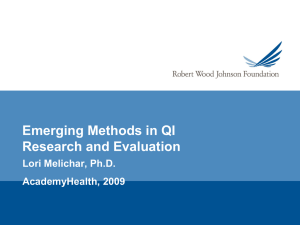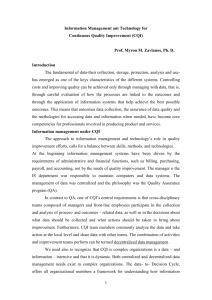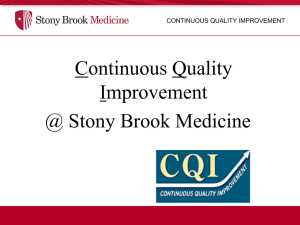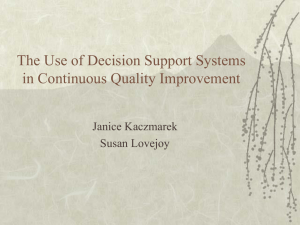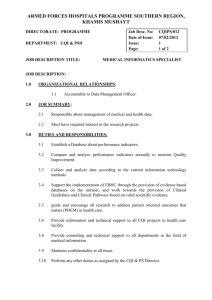IEEE C802.16m-09/ 2710r1 Project Title
advertisement
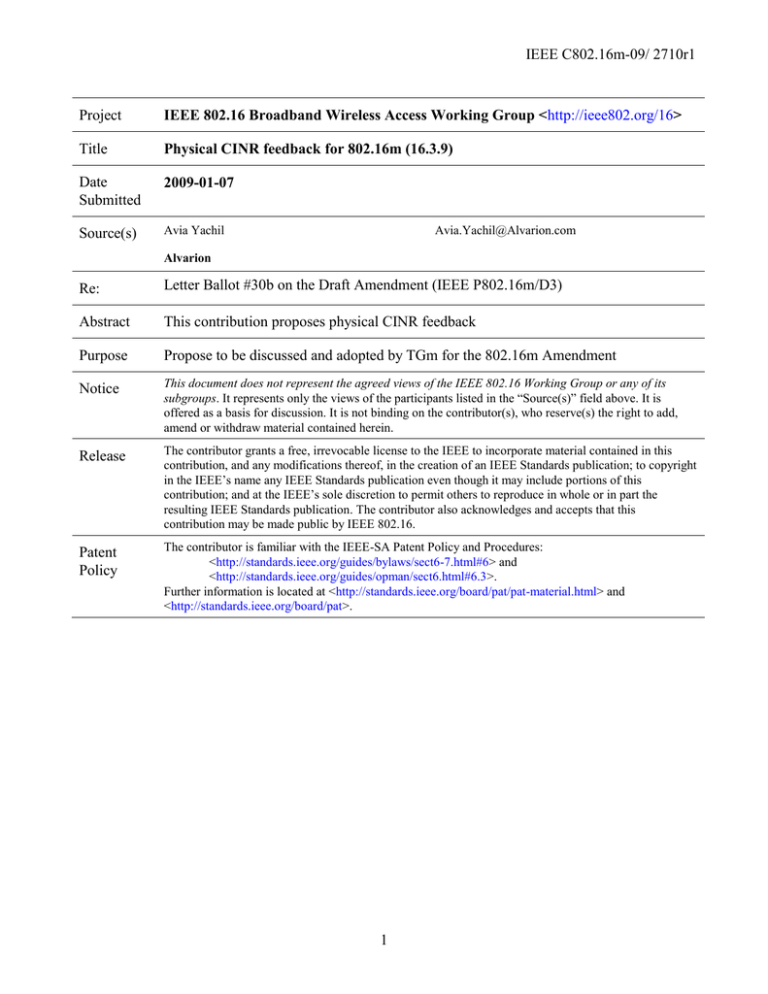
IEEE C802.16m-09/ 2710r1
Project
IEEE 802.16 Broadband Wireless Access Working Group <http://ieee802.org/16>
Title
Physical CINR feedback for 802.16m (16.3.9)
Date
Submitted
2009-01-07
Source(s)
Avia Yachil
Avia.Yachil@Alvarion.com
Alvarion
Re:
Letter Ballot #30b on the Draft Amendment (IEEE P802.16m/D3)
Abstract
This contribution proposes physical CINR feedback
Purpose
Propose to be discussed and adopted by TGm for the 802.16m Amendment
Notice
This document does not represent the agreed views of the IEEE 802.16 Working Group or any of its
subgroups. It represents only the views of the participants listed in the “Source(s)” field above. It is
offered as a basis for discussion. It is not binding on the contributor(s), who reserve(s) the right to add,
amend or withdraw material contained herein.
Release
The contributor grants a free, irrevocable license to the IEEE to incorporate material contained in this
contribution, and any modifications thereof, in the creation of an IEEE Standards publication; to copyright
in the IEEE’s name any IEEE Standards publication even though it may include portions of this
contribution; and at the IEEE’s sole discretion to permit others to reproduce in whole or in part the
resulting IEEE Standards publication. The contributor also acknowledges and accepts that this
contribution may be made public by IEEE 802.16.
Patent
Policy
The contributor is familiar with the IEEE-SA Patent Policy and Procedures:
<http://standards.ieee.org/guides/bylaws/sect6-7.html#6> and
<http://standards.ieee.org/guides/opman/sect6.html#6.3>.
Further information is located at <http://standards.ieee.org/board/pat/pat-material.html> and
<http://standards.ieee.org/board/pat>.
1
IEEE C802.16m-09/ 2710r1
Physical CINR feedback for 802.16m (16.3.9)
Avia Yachil
Alvarion
I.
Introduction
In current IEEE 802.16m specification [1], the feedback allocation A-MAP IE (16.3.6.5.2.4.5) defines:
The channel resource allocation
The periodicity of the feedback and its duration
The MIMO-feedback mode and its corresponding parameters.
The standard defines 7 MIMO-feedback modes (16.3.7.2.5.4) where all modes enable a feedback
content of Channel Quality Indicator (i.e. CQI) (table 839).
The CQI definition (16.3.9.3.1.3) composes of a spectral-efficiency recommendation from the AMS,
based on some pre-defined criteria:
Assuming 4 LRUs in type-1 AAI subframe as a resource allocation.
Target block-error rate that do not exceed 10% for the first HARQ transmission
For MU-MIMO modes with code-book based feedback it is assumed the interfering users are
scheduled using rank-1 pre-coders orthogonal to each other and orthogonal to the rank-1
precoder represented by the reported PMI.
It is also expected from the ABS to adjust the spectral-efficiency based on delay and mobility
conditions.
“The CQI feedback together with the rank feedback (when applicable) composes the spectral efficiency value reported by
the AMS. This value corresponds to the measured block error rate which is the closest, but not exceeding, a specific target
error rate.
The AMS reports the CQI by selecting a nominal MCS index from Table 901. MCS index should be selected assuming 4
LRUs in type-1 AAI subframe as a resource allocation, and 10% as a target error rate for the first HARQ transmission. In
order to allocate the AMS with MCS level and rank appropriate for the actual requirements, the ABS should make
adjustments to the AMS reported spectral efficiency, by considering parameters values different from the reference ones
and by adapting to delay and mobility conditions.”
We find this CQI definition to be insufficient as it strongly depends on the CPE translation of the
above criteria to a quantized MCS table (table 901) which is not known to the ABS. Moreover the
above criteria may not be optimal for the spectral-efficiency for all QoS and scheduling schemes.
Therefore the current CQI definition limits the ABS to adjust the spectral-efficiency to delay and
mobility is limited.
In this contribution we suggest to support additional CQI feedback that is based on DL physical CINR
measurements that the AMS provides the ABS over the feedback channel.
The physical CINR measurement is not subjected to predefined criteria and provides flexibility for the
ABS to optimize the rate-selection.
In addition, the standard specifies ‘DL CINR Report Operation’ (16.2.8.2.8) where it states:
“An ABS may assign FastFeedback channels to each carrier of an AMS. When FastFeedback channel is assigned, the AMS
reports CINR for a carrier over the assigned FastFeedback channel of the corresponding carrier. ABS may also direct AMS
2
IEEE C802.16m-09/ 2710r1
to report CINRs of active carriers through FastFeedback channel(s) on the primary carrier at the feedback region as defined
in Section 15.3.8.3.3. …“
Unfortunately the standard does not specify the mechanism of the CINR report over the feedback
channel, nor over the MAC-messages.
More sections relate to the CQI as a feedback of SINR as it is stated in (16.3.5.4) Pilot Structure:
“The transmission of pilot subcarriers in the downlink is necessary for enabling channel estimation, measurements of
channel quality indicators such as the SINR, frequency offset estimation, etc. “
Therefore, we are motivated to define physical CINR reports as a channel-quality indicator (CQI) and
utilize the feedback-channel for it.
Proposed text:
Insert the following text into section 16.3.6.5.2.4.5 ‘Feedback Allocation A-Map IE’
3
IEEE C802.16m-09/ 2710r1
4
IEEE C802.16m-09/ 2710r1
5
IEEE C802.16m-09/ 2710r1
6
IEEE C802.16m-09/ 2710r1
Add the following entries to table 821: (page427, lines 1-9 ):
------------------------------------------------ Start of text-----------------------------------------------------------Syntax
Size (bit)
Notes
CQI type
1
Indicates which CQI type is required
to be reported in this feedbackchannel:
0b0: use MCS recommendation as
CQI information: table 901
0b1: use physical CINR measurement
as CQI information.
If(CQI type == 0b1)
short term CINR
3
Determines the required CINR
calculation for the short-term reports
based on the bellow MIMO encoding
format:
0b000: use physical CINR
measurement over A-preamble as
CQI information
0b001: use physical CINR
measurement over pilots of data:
SFBC as CQI information
0b010: use physical CINR
measurement over pilots of data: VE
as CQI information
0b011: use physical CINR
measurement over pilots of data: HE
as CQI information
0b101: use physical CINR
measurement over pilots of data:
CDR as CQI information
0b110: use physical CINR
measurement over MIMO midamble
as CQI information
long term CINR
3
Determines the required CINR
calculation for the long-term reports
based on the bellow MIMO encoding
format:
0b000: use physical CINR
measurement over A-preamble as
CQI information
0b001: use physical CINR
measurement over pilots of data:
SFBC as CQI information
7
IEEE C802.16m-09/ 2710r1
0b010: use physical CINR
measurement over pilots of data: VE
as CQI information
0b011: use physical CINR
measurement over pilots of data: HE
as CQI information
0b101: use physical CINR
measurement over pilots of data:
CDR as CQI information
0b110: use physical CINR
measurement over MIMO midamble
as CQI information
}
Padding
}
Variable
------------------------------------------------ End of text-----------------------------------------------------------Change the following text into section 16.3.9.3.1.5 ’Feedback Format’
------------------------------------------------ Start of text-----------------------------------------------------------Feedback format for MFM 0,1,4,7
Feedback formats for MFM 0, 1, 4, and 7 are listed in Table 902. Short term report happens in every reporting period as
defined in feedback allocation A-MAP IE, long term report will puncture short term report according to long term feedback
period in feedback allocation A-MAP IE. The long period report shall start by puncturing the first short period report if
MFM = 4 or 7, or by puncturing the 2 q-th short period report if MFM = 0 or 1, where q is defined in the feedback allocation
A-MAP IE. The wideband CQI is classified by the ‘CQI type’ defined in the feedback allocation A-MAP IE:
If the CQI type is a recommended MCS (0b0) then wideband CQI is one average CQI corresponding to the MIMO
mode signaled by the combination MFM and STC rate, with averaging over the whole band. In the case where the
number of DL frequency partitions FPCT > 1, the wideband CQI is one average CQI over the corresponding frequency
partition.
If the CQI type is a physical CINR (0b1), then the wideband CQI is determined by short-term and long-term CINR
determined in short-term CINR and long-term CINR respectively.
Table 902 shows feedback formats for MIMO feedback mode 0, 1, 4, and 7 when Measurement Method Indication = 0b0 in
Feedback Allocation A-MAP IE (operation outside the open-loop region):
…
Table 903 shows feedback formats for MIMO feedback mode 0 and 1 when Measurement Method Indication = 0b1 in
Feedback Allocation A-MAP IE (operation inside the open-loop region). The ABS shall not assign a feedback channel on
the short periods. The ABS will
8
IEEE C802.16m-09/ 2710r1
Feedback format for MFM 2:
The detailed format is listed in Table 904. Short term report happens in every reporting period as defined in feedback
allocation A-MAP IE, long term report will puncture short term report according to long term feedback period in feedback
allocation A-MAP IE. The long period report shall start by puncturing the first short period report. If the PFBCH indicator
in SFBCH is set to '1', PFBCH is transmitted by puncturing SFBCH in the next feedback opportunity regardless of shortterm and long-term feedback using encoding type 0.
The subband CQI is classified by the ‘CQI type’ defined in the feedback allocation A-MAP IE:
If the CQI type is a recommended MCS (0b0) then the CQI of subband m shall be computed as follows:
(Subband m CQI index) = (Subband avg CQI index) +Subband m differential CQI), using the latest available
reports of Subband avg CQI and Subband differential CQI. Subband avg CQI index is an average measure of the
CQI over the M reported subbands. The possible differential CQI values are {-1, 0, +1, +2}. The AMS shall ensure
that the reported differential CQI will produce a value of subband m CQI in the range of 0 to 15.
For PFBCH reports, if the CQI type is a physical CINR (0b1) then the subband CQI is the avg CINR calculated
over the subband indexes only.
….
Feedback format for MFM 3:
The detailed format is listed in Table 906. Short term report happens in every reporting period as defined in feedback
allocation A-MAP IE, long term report will puncture short term report according to long term feedback period in feedback
allocation A-MAP IE. The long period report shall start by puncturing the first short period report. For feedback format 0
with 3 reports using the PFBCH, Subband PMI shall be transmitted first after every report of Best_subbands_ index.
Subband CQI and subband PMI are then transmitted alternately and Best_subbands_index is transmitted in the long term
period. If the PFBCH indicator in SFBCH is set to '1', PFBCH is transmitted using encoding type 0 by puncturing SFBCH
in the next feedback opportunity regardless of short-term and long-term feedback.
The subband CQI is classified by the ‘CQI type’ defined in the feedback allocation A-MAP IE:
If the CQI type is a recommended MCS (0b0) then the CQI of subband m shall be computed as follows for the first
short period report following a long period report: (Subband m CQI index) = (Subband avg CQI index) +
(Subband m differential CQI). Subband avg CQI index is an average measure of the CQI over the M reported
subbands. The possible differential CQI values are {-1, 0, +1, +2}. The AMS shall ensure that the reported
differential CQI will produce a value of subband m CQI in the range of 0 to 15.
For PFBCH reports, if the CQI type is a physical CINR (0b1) then the subband CQI is the avg CINR calculated
over the subband indexes only.
….
Feedback format for MFM 6:
The detailed format is listed in Table 909. Short term report happens in every reporting period as defined in feedback
allocation A-MAP IE, long term report will puncture short term report according to long term feedback period in feedback
allocation A-MAP IE. The long period report shall start by puncturing the first short period report. For feedback format 0
with 3 reports using the PFBCH, Subband PMI shall be transmitted first after every report of Best_subbands_index.
Subband CQI and subband PMI are then transmitted alternately and Best_subbands_index is transmitted in the long term
period. If the PFBCH indicator in SFBCH is set to '1', PFBCH is transmitted using encoding type 0 by puncturing SFBCH
in the next feedback opportunity regardless of short-term and long-term feedback.
The subband CQI is classified by the ‘CQI type’ defined in the feedback allocation A-MAP IE:
9
IEEE C802.16m-09/ 2710r1
If the CQI type is a recommended MCS (0b0) then the CQI of subband m shall be computed as follows: (Subband
m CQI index) = (Subband avg CQI index) + (Subband m differential CQI), using the latest available reports of
Subband avg CQI and Subband differential CQI. Subband avg CQI index is an average measure of the CQI over
the M reported subbands. The possible differential CQI values are {-1, 0, +1, +2}. The AMS shall ensure that the
reported differential CQI will produce a value of subband m CQI in the range of 0 to 15.
For PFBCH reports, if the CQI type is a physical CINR (0b1) then the subband CQI is the avg CINR calculated
over the subband indexes only.
…
------------------------------------------------ End of text------------------------------------------------------------
Add the following text into section 16.3.9.3.1.3 ’Channel Quality Indicator (CQI) definition’:
------------------------------------------------ Start of text-----------------------------------------------------------16.3.9.3.1.3 Channel quality indicator (CQI) definition
The CQI feedback can be classified as follows:
A nominal MCS index (along with rank feedback when applicable) that composes the spectral
efficiency value that is recommneded by the AMS: MCS-based CQI
A DL CINR measurement reported by the AMS: CINR-based CQI
The ABS instructs the AMS which CQI feedback is required via the feedback Allocation A-Map IE
(16.3.6.5.2.4.5) using the CQI_Type field.
The following sections specifies the two report schemes.
16.3.9.3.1.3.1 MCS-based CQI definition
Copy the current 16.3.9.3.1.3 content into this sub-section:
“The CQI feedback together with the rank feedback (when applicable) composes the spectral efficiency value reported by
the AMS. This value corresponds to the measured block error rate which is the closest, but not exceeding, a specific target
error rate. ….”
…
16.3.9.3.1.3.2 CINR-based CQI definition
There are three CINR measurements types.
1. CINR that is based on A-Preamble (16.3.9.3.1.3.2.xx)
2. CINR that is based on MIMO midamble (16.3.9.3.1.3.2.xx)
3. CINR that is based on pilots of data (16.3.9.3.1.3.2.xx)
For the CINR measurement that is based on pilots of data, we distinguish between four CINR
formulations, based on the transmitted MIMO Encoding Formats (MEF): SFBC, VE, HE and CDR.
The required MEF is instructed to the AMS via: DL Basic Assignment A-Map IE (16.3.6.5.2.4.1), DL
Subband Assignment A-Map IE and DL Persistent A-Map IE. The MEF and further DL MIMO
1
0
IEEE C802.16m-09/ 2710r1
control-parameters (Table 840) (e.g. Mt, Nt) are needed for the AMS to calculate the CINR over the
pilots of data.
The ABS instructs the AMS which of the three CINR feedbacks is required via the feedback
Allocation A-Map IE (16.3.6.5.2.4.5) using the short/long term CINR field.
The AMS measurs the DL CINR and reports the DL CINR via one of the code-word in the range
[0:50]. The mapping of the code-word ‘CQI’ to ‘CINR’ is as follows:
CINR CQI 10
Equation 1: CQI code-word mapping to CINR
The CINR report is quantized in steps of 1 dB in the range: -10 to 40.
------------------------------------------------ End of text-----------------------------------------------------------Add the following text into section 16.3.5.4.3 ’Usage of Downlink Pilots’
------------------------------------------------ Start of text-----------------------------------------------------------“Channel estimation for demodulation of data burst and CINR calculation at AMS should be
performed as follows:
In DLRU:
the 2 streams non-adaptively precoded common pilots across the DLRU should be used for channel
estimation and CINR calculation by all AMSs allocated a burst in the DLRU. Within each
frequency partition, all pilots are shared by all AMSs for demodulation in DLRU.
In CLRU:
The AMS should use its dedicated pilot streams for channel estimation and CINR calculation in the
allocation. Pilots are not shared by AMSs for demodulation in CLRU, whether they are nonadaptively or adaptively precoded.”
------------------------------------------------ End of text------------------------------------------------------------
Reference
[1] IEEE 802.16m/D3, Part 16: Air Interface for Broadband Wireless Access Systems, Advanced Air
Interface
1
1

